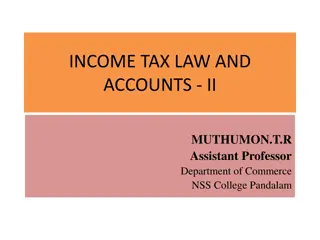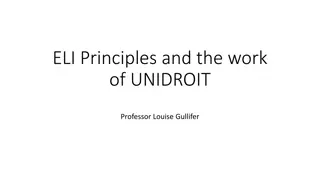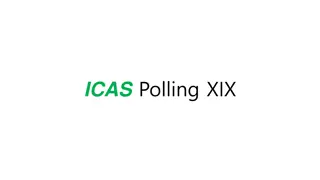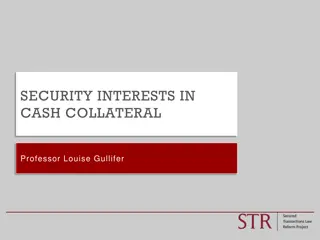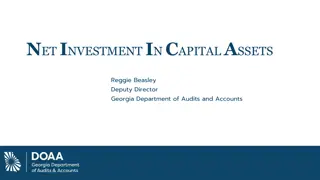Security Interests in Digital Assets under Korean Law - Possibility, Limitations, and Legal Gaps
The challenges and legal complexities surrounding security interests in digital assets under Korean law, focusing on enforcement, classification, and property rights in the context of virtual assets. Analyzing attachment mechanisms, legal ambiguities, and potential improvements for better legal protection.
Download Presentation

Please find below an Image/Link to download the presentation.
The content on the website is provided AS IS for your information and personal use only. It may not be sold, licensed, or shared on other websites without obtaining consent from the author.If you encounter any issues during the download, it is possible that the publisher has removed the file from their server.
You are allowed to download the files provided on this website for personal or commercial use, subject to the condition that they are used lawfully. All files are the property of their respective owners.
The content on the website is provided AS IS for your information and personal use only. It may not be sold, licensed, or shared on other websites without obtaining consent from the author.
E N D
Presentation Transcript
Security Interests in Digital Assets under Korean Law Security Interests in Digital Assets under Korean Law - - Possibility, Limitations and Legal Protection Gaps Possibility, Limitations and Legal Protection Gaps Korea Advanced Institute of Science and Technology (KAIST) WooJung Jon
Legal Challenges of Enforcement of Virtual Assets Definition of Virtual Assets: Under Korean Virtual Asset User Protection Act, virtual assets ( ) generally refer to digital tokens or electronic certificates with economic value that can be electronically traded or transferred. Common examples include cryptocurrencies like Bitcoin and Ethereum. Unlike traditional tangible assets, virtual assets exist as digital information recorded on a blockchain and do not constitute things ( ) under the Civil Act i.e. they are not corporeal objects or electricity as defined by law. Nevertheless, they are recognized as having property value. Legal Context of Attachment: In Korea, attachment ( ) is a legal mechanism used in both tax enforcement and civil judgment enforcement to seize or freeze a debtor s assets to satisfy obligations. The Korean Civil Execution Act ( ) provides distinct procedures depending on the type of asset for example, different rules govern immovable property, movables, claims ( ), securities, and other property rights ( ). Virtual assets do not squarely fall into traditional categories like tangible movables or securities. This classification has important implications for how attachment is carried out. Recent regulatory developments and court decisions in Korea have started to address the challenges of enforcing against virtual assets, but significant legal ambiguities remain. Today, I will analyze the enforceability of attachment measures on virtual assets under current Korean law, focusing on the Korean National Tax Collection Act for tax seizures and the Korean Civil Execution Act for private civil judgments, and discusses potential improvements.
Civil Law Definition of Property Traditional Definition Virtual Assets = Uncharted Ownership Ambiguity In civil-law systems, "property" usually covers tangible objects. E.g.Korea's Civil Act Article 98 defines "things" as corporeal objects or controllable natural forces (like electricity). Virtual assets are intangible data entries on a ledger, not physical things or natural forces." They do not neatly fit the Article 98 definition of a transferable thing. Because they fall outside classical definitions, it is unclear if one's hold over cryptocurrency is a property right under civil law. This ambiguity undermines legal protection and transactions involving virtual assets.
Issues in Classification Neither Tangible nor Claim Excluded from Property 1 2 Virtual assets have no physical form and are not a right against another party. They are sui generis digital units, challenging the binary of chose-in-possession (tangible property) vs. chose-in-action (claim). Some courts in strict civil law jurisdictions refuse to treat crypto as "property." For example, Japanese courts ruled that Bitcoin is not "a thing" under the Civil Code, since only corporeal objects qualify as property. Legal Gap Comparative Note 3 4 This strict classification means holders of virtual assets may lack full property-rights protection (e.g. in theft or insolvency) because the law doesn't recognize their assets as property. In contrast, common-law courts increasingly recognize crypto as property (as an intangible asset), but civil-law codes have been slower to adapt, highlighting a need for legislative clarification.
Challenges in Security Rights (Collateral) Pledging Difficulties No Clear Framework Traditional pledge law assumes a transfer of possession of a thing to the creditor. With virtual assets, there is no physical possession control of the private key is the closest equivalent. Many secured transactions laws (e.g. civil codes, UCC Article 9 equivalents) did not envision digital tokens. It's uncertain how to "perfect" a security interest in crypto by registration, control, or other means under existing laws. Risk for Lenders Market Adaptation Without legal clarity, lenders face risk in accepting crypto as collateral. A debtor could secretly transfer the asset, or courts might later rule the security interest invalid if the asset isn't recognized as property. In practice, parties resort to contractual solutions (e.g. taking control of the borrower's wallet) to mitigate these uncertainties, but this workaround underscores the need for statutory guidance.
Methods of Securing Virtual Assets Possessory Pledge (Control) Title Transfer for Security Security Trust (Escrow) Smart Contract Collateral (DeFi) The asset is placed with a third- party trustee or custodian who holds it for the benefit of the creditor until the obligation is fulfilled. The trustee arrangement secures the asset and can act impartially, ensuring the debtor can't unilaterally misappropriate it. Creditor takes control of the asset (e.g. moving coins to a wallet controlled by the lender or handing over a hardware wallet). This mimics possession and might perfect a pledge by control of the private key. Debtor transfers ownership of the virtual asset to the creditor (or an agent) as collateral, under an agreement that it will be returned upon debt repayment. This outright transfer secures the debt but blurs legal ownership during the loan. Borrower locks the asset in a smart contract that automatically enforces the loan terms. The code will hold the crypto, trigger liquidation if default occurs, and release collateral when the loan is repaid. (This provides technical security without relying on a central party, though legal recognition of such arrangements is still evolving.)
Attachment of Virtual Assets Under the Korean National Tax Collection Act Legal Framework (Article 55(3) NTCA): The National Tax Collection Act ( ) empowers tax authorities to seize a delinquent taxpayer s assets for unpaid national taxes. In recognition of virtual assets as a form of property, Article 55(3) of the Act (added by a 2021 amendment) provides a procedure for attaching virtual assets as other property rights. In essence, when a tax debtor owns virtual assets, the head of the tax office may issue a demand for transfer of the virtual asset as the method of attachment. This demand can be directed either to the taxpayer themselves or to a third party that is holding the taxpayer s virtual asset (such as a cryptocurrency exchange or custodian). This approach differs from seizing a physical object instead of physically taking an asset, the tax authority secures control by ordering its transfer into a government-controlled account or wallet. Notably, virtual assets are thus classified under the category of other property rights, distinct from movables, securities, or standard claims in the enforcement scheme. This classification recognizes that crypto-assets are neither tangible chattels nor mere payment claims, but unique digital property interests. Attachment Procedure by Tax Authorities: Pursuant to the Act and its enforcement regulations, the attachment process for virtual assets involves several steps designed for the asset s digital nature. First, the tax office serves a transfer request to the debtor or the relevant virtual asset service provider (VASP) (e.g. the exchange holding the asset) demanding that the asset be transferred. If the asset is held on a domestic exchange, that exchange is obligated to move the asset into an account or wallet designated by the tax authority (often an account in the name of the tax office). For example, if a delinquent taxpayer s Bitcoin is held in an exchange account, the exchange must transfer the Bitcoin to a government account specified by the tax officer. This effectively freezes and seizes the asset, preventing the taxpayer from moving or liquidating it. If the virtual asset is held by the taxpayer personally (such as in a private wallet), the tax authority will issue the transfer order to the taxpayer directly. Non- compliance is a serious concern in such cases. Post-Attachment Disposal: Once a virtual asset is successfully attached (transferred into the tax authority s control), the NTCA allows for its liquidation to satisfy tax arrears. In a departure from traditional public auction methods, the law permits the tax office to sell the seized virtual asset through a virtual asset exchange at market price. This was designed to efficiently convert crypto to cash, recognizing that exchanges provide a ready market. For instance, the National Tax Service has directly sold seized cryptocurrency on exchanges and applied the proceeds to the taxpayer s debt. This direct sale mechanism is an exception to the usual rule of selling seized assets via public auction, reflecting the practicality of using exchanges for crypto assets. It underscores that the legal system views virtual assets as having real monetary value, while also acknowledging their volatility and the need for prompt conversion. In sum, under the NTCA the enforceability of attachment on virtual assets is robust: the law provides clear authority to freeze and take control of a delinquent s crypto holdings and even to liquidate them, thereby integrating virtual assets into the tax collection regime.
Attachment of Virtual Asset Claims Under the Korean Civil Execution Act Civil Enforcement via Claim Attachment: In the context of private debts and civil judgments, there is no special statute exclusively addressing virtual assets. Creditors and courts have therefore analogized virtual assets to intangible claims for enforcement purposes. The prevailing legal practice is to attach the debtor s claim against the exchange or custodian holding the virtual asset, rather than the virtual asset itself. In other words, if a judgment debtor has cryptocurrency deposited with a Korean exchange, the creditor will seek to garnish the debtor s right to withdraw or receive that cryptocurrency from the exchange. This is procedurally done under the Korean Civil Execution Act provisions for attaching claims ( ), treating the exchange as a third-party obligor ( ). Once the court issues an attachment order against the claim, the exchange (as garnishee) is prohibited from returning the asset to the debtor and must eventually deliver the asset (or its value) to the creditor to satisfy the debt. Attachment of Claim vs. Asset: It is critical to distinguish between attaching a claim to a virtual asset and directly attaching the virtual asset. In legal terms, what is being seized in civil proceedings is the debtor s right to claim delivery of the virtual asset from the exchange, which is a form of intangible claim ( ). The actual cryptocurrency remains in the custody of the exchange, but it is frozen by virtue of the attachment order served on the exchange. The exchange assumes a legal duty akin to a garnishee in a bank account seizure: it must not allow any withdrawals or transfers of the asset to the debtor once it has been served with the order. The debtor s right in the crypto is thereby encumbered. This method leverages the cooperation of the intermediary to ensure the asset s value is preserved for execution. By contrast, a direct attachment of the cryptocurrency (if it were attempted) would imply seizing a thing that is not in the possession of any third party a far more challenging scenario addressed in the next section. In practice, Korean courts have recognized that the relationship between an exchange and its user with respect to crypto is contractual, often likened to a deposit or custody arrangement. However, since cryptocurrency is not a thing under the Korean Civil Act, the user s interest is not a possessory right in specific coins but rather a personal claim against the exchange for an equivalent amount of cryptocurrency. It demonstrates that, at least where the crypto is held by an identifiable third party, the existing legal tools (attachment of a claim and subsequent sale) can be used to reach the asset s value. The court explicitly acknowledged the unique nature of virtual assets but operated within the Civil Execution Act s framework by treating the asset as an object of a claim. This approach is effective only so long as the asset remains with a cooperative third party like an exchange. Under these circumstances, ownership and enforceability are clear: the debtor is the owner of the asset (via their contractual rights), and the attachment transfers the enforcement rights to the creditor, while the exchange s compliance ensures the asset can be realized for payment. It is a pragmatic workaround that achieves the goal of enforcement without needing new legislation, but it leaves open the question of assets outside the exchange system.
Legislative Approaches (Comparative) U.S. UCC Article 12 UNIDROIT Principles 2023 The Uniform Commercial Code was updated in 2022 to address digital assets. Article 12 defines "controllable electronic records" (covering cryptocurrencies, NFTs, etc.) and provides rules for their transfer and for security interests in them. Notably, it introduces the concept of control as a way to perfect a security interest (analogous to possession for intangibles). An international effort led by UNIDROIT established Principles on Digital Assets and Private Law. These principles broadly define digital assets and set out basic rules for ownership, transfer, and third-party effectiveness, aiming for global harmonization. They endorse using "control" as a key concept and encourage legal systems to recognize digital assets as objects of property rights.
Summary of Legal Gaps Property Definition Collateral Laws 1 Virtual assets often do not qualify as "property" under civil codes Existing collateral laws do not squarely cover virtual assets 2 Legal Protection Enforcement Procedures 4 Owners and creditors lack the legal tools and protections available for traditional assets Enforcement procedures are ill- equipped to deal with self-custodied, borderless assets 3
Need for Reform Update Legal Definitions There is a growing consensus that legislatures must update legal definitions and frameworks to integrate virtual assets. Expand Property Notion Scholars and law commissions urge expanding the notion of property to encompass digital assets or creating a new category fo r them. Adopt Control Concept Security transaction laws should adopt the concept of control (similar to UCC Article 12) to allow effective pledges of crypto. Empower Courts Enforcement laws should empower courts to reach these assets (while balancing due process and privacy).
Policy Recommendations Draw on Emerging Models Harmonize Internationally Ensure Legal Clarity 1 2 3 Harmonizing these rules internationally would reduce uncertainty. Legal clarity and certainty in this area will support innovation in the digital economy while protecting rights and maintaining financial stability ensuring that virtual assets can be integrated into the legal system rather than exist in a regulatory gray area. Policymakers should draw on emerging models (UCC Article 12's approach, UNIDROIT principles) to craft clear rules defining control of virtual assets and mechanisms for using them as collateral.






